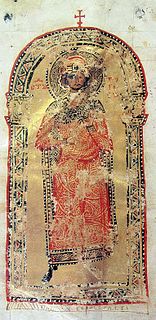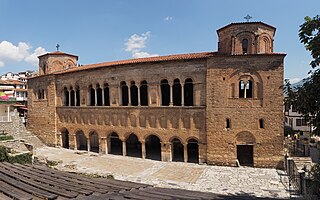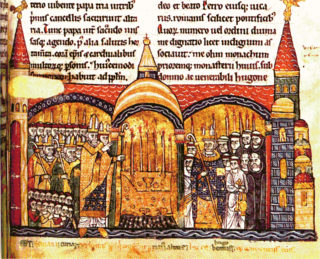
The Eastern Orthodox Church, also called the Orthodox Church, is the second-largest Christian church, with approximately 220 million baptised/baptized members. It operates as a communion of autocephalous congregations, each governed by its bishops and adherents in local synods. The church has no central doctrinal or governmental authority analogous to the Head of the Roman Catholic Church, the Pope, but the Ecumenical Patriarch of Constantinople is recognized by them as primus inter pares and regarded as the spiritual leader of many of the eastern Christian parishes. As one of the oldest surviving religious institutions in the world, the Eastern Orthodox Church has played a prominent role in the history and culture of Eastern and Southeastern Europe, the Caucasus, and the Near East. The Eastern Orthodox Church officially calls itself the Orthodox Catholic Church.

Cyril and Methodius (815–885) were two brothers and Byzantine Christian theologians and missionaries. For their work evangelizing the Slavs, they are known as the "Apostles to the Slavs".

Slavs are an ethno-linguistic group of people who speak the various Slavic languages of the larger Balto-Slavic linguistic group of the Indo-European languages. They are native to Eurasia, stretching from Central, Southeastern and Eastern Europe, all the way north and eastwards to Northeast Europe, Northern Asia, and Central Asia, as well as historically in Western Europe and Western Asia. From the early 6th century they spread to inhabit most of Central, Eastern and Southeastern Europe. Today, there is a large Slavic diaspora throughout the Americas, particularly in the United States, Canada, Brazil and Argentina as a result of immigration.

Boris I, also known as Boris-Mihail (Michael) and Bogoris, was the ruler of the First Bulgarian Empire in 852–889. At the time of his baptism in 864, Boris was named Michael after his godfather, Emperor Michael III. The historian Steven Runciman called him one of the greatest persons in history.

The Serbian Orthodox Church is one of the autocephalous Eastern Orthodox Christian churches.

The Orthodox Church of the Czech Lands and Slovakia is a self-governing body of the Eastern Orthodox Church that territorially covers the countries of the Czech Republic and Slovakia. The current primate of the Czech and Slovak Orthodox Church is Rastislav of Prešov, Metropolitan of the Czech Lands and Slovakia since 2014.

The Early Cyrillic alphabet, also called classical Cyrillic or paleo-Cyrillic, is a writing system that was developed in the First Bulgarian Empire during the late 9th century on the basis of the Greek alphabet for the Slavic peoples living near the Byzantine Empire in South East and Central Europe. It was used by Slavic peoples in South East, Central and Eastern Europe.

The Bulgarian Orthodox Church, legally the Patriarchate of Bulgaria, is an autocephalous Orthodox jurisdiction. It is the oldest Slavic Orthodox church, with some 6 million members in Bulgaria and between 1.5 and 2 million members in a number of European countries, the Americas, Australia, New Zealand and Asia. It was recognized as autocephalous in 1945 by the Ecumenical Patriarchate of Constantinople.
Religion in Montenegro refers to adherents, communities, institutions and organizations of various religions in Montenegro. While Eastern Orthodox Christianity is the dominant religious denomination in Montenegro, there are also sizable numbers of adherents of both Catholic Christianity and Islam. The majority Orthodox is the Serbian Orthodox Church and the minority are present traces of a forming not canonically Montenegrin Orthodox Church who is not recognized by the Orthodox Christian Church. According to the 2020 estimate by the Pew Research Center, 76.6% of the population is Christian, 20.3% are Muslims, and 3.1% are unaffiliated.

Religion in Bulgaria has been dominated by Christianity since its adoption as the state religion in 865. The dominant form of the religion is Eastern Orthodox Christianity within the fold of the Bulgarian Orthodox Church. During the Ottoman rule of the Balkans, Sunni Islam spread in the territories of Bulgaria, and it remains a significant minority today. The Catholic Church has roots in the country since the Middle Ages, and Protestantism arrived in the 19th century.

Religion in Ukraine is diverse, with a majority of the population adhering to Christianity. A 2018 survey conducted by the Razumkov Centre found that 71.7% of the population declared themselves believers. About 67.3% of the population declared adherence to one or another strand of Orthodox Christianity, 7.7% 'Christian' with no declared denominational affiliation, 9.4% Ukrainian Byzantine Rite Catholics, 2.2% Protestants and 0.8% Latin Rite Catholics, 2.5 % Islam, Judaism was the religion of the 0.4%; while a small percentage follow Hinduism, Buddhism and Paganism (Rodnovery). A further 11.0% declared themselves non-religious or unaffiliated. According to the surveys conducted by Razumkov in the 2000s and early 2010s, such proportions have remained relatively constant throughout the last decade, while the proportion of believers overall has decreased from 76% in 2014 to 70% in 2016 and 72% in 2018.

Eastern Orthodoxy is the main Christian denomination in Serbia, with 6,079,396 followers or 84.6% of the population, followed traditionally by the majority of Serbs, and also Romanians, Vlachs, Montenegrins, Macedonians and Bulgarians living in Serbia. The dominant Eastern Orthodox church in Serbia is the Serbian Orthodox Church. Also, the Romanian Orthodox Church has its own Diocese of Dacia Felix that operates among Orthodox Romanians in Serbian Banat and the Timok Valley.

In North Macedonia, the most common religion is Eastern Orthodox Christianity, practiced by most of the ethnic Macedonians. The vast majority of the Eastern Orthodox in the country belong to the Macedonian Orthodox Church, which declared autocephaly from the Serbian Orthodox Church in 1967.

In AD 1453, the city of Constantinople, the capital and last stronghold of the Byzantine Empire, fell to the Ottoman Empire. By this time Egypt had been under Muslim control for some seven centuries. Jerusalem had been conquered by the Umayyad Muslims in 638, won back by Rome in 1099 under the First Crusade and then reconquered by Saladin's forces during the siege of Jerusalem in 1187. Later in the sevenths Crusade, it was taken back by the Catholics once again. It was conquered by the Ottomans in 1517. Orthodoxy, however, was very strong in Russia which had recently acquired an autocephalous status; and thus Moscow called itself the Third Rome, as the cultural heir of Constantinople. Under Ottoman rule, the Greek Orthodox Church acquired power as an autonomous millet. The ecumenical patriarch was the religious and administrative ruler of the entire "Greek Orthodox nation", which encompassed all the Eastern Orthodox subjects of the Empire.

In 9th-century Christianity, Charlemagne was crowned as Holy Roman Emperor, which continued the Photian schism.

By the 10th century, Christianity had spread throughout much of Europe and Asia. The Church in England was becoming well established, with its scholarly monasteries, and the Roman Church and the Eastern Orthodox Church were continuing their separation, ultimately culminating in the Great Schism.

Christianity is the predominant religion in Serbia. The Constitution of Serbia defines it as a secular state with guaranteed religious freedom. Eastern Orthodox Christians comprise 84.5% of country's population with 6,079,396 members. The Serbian Orthodox Church is the largest and traditional church of the country, adherents of which are overwhelmingly Serbs. Public schools in Serbia allow religious teaching, most commonly with the Serbian Orthodox Church. Serbian public holidays include the religious celebrations of Eastern Orthodox Christians. Other Orthodox Christian communities in Serbia include Montenegrins, Romanians, Vlachs, Macedonians and Bulgarians. The Catholic Church is prominent in north Vojvodina amongst the Hungarian minority. Protestantism is most largely found in Slovak populations within Bački Petrovac and Kovačica. Christianity first arrived in Serbia in the 9th century. It became state-religion in the 9th century when Serbia began to identify as a Christian country. In a 2011 census, 91.22% of Serbians identified as Christian.

The Eastern Orthodoxy in Europe constitutes the second largest Christian denomination. European Eastern Orthodox Christians are predominantly present in Eastern and Southeastern Europe, and they are also significantly represented in diaspora throughout the Continent. The term Eastern Orthodox Europe is informally used to describe the predominantly Eastern Orthodox countries of Eastern Europe, as well as, Belarus, Bulgaria, Cyprus, Georgia, Greece, Moldova, Montenegro, Republic of North Macedonia, Romania, Russia, Serbia and Ukraine.

Based on the numbers of adherents, the Eastern Orthodox Church is the second largest Christian communion in the world, after the Roman Catholic Church, with the most common estimates of baptised members being approximately 220 million. The numerous Protestant groups in the world, if taken all together, substantially outnumber the Eastern Orthodox, but they differ theologically and do not form a single communion.

The Slavs were Christianized in waves from the 7th to 12th century, though the process of replacing old Slavic religious practices began as early as the 6th century. Generally speaking, the monarchs of the South Slavs adopted Christianity in the 9th century, the East Slavs in the 10th, and the West Slavs between the 9th and 12th century. Saints Cyril and Methodius are attributed as "Apostles to the Slavs", having introduced the Byzantine-Slavic rite and Glagolitic alphabet, the oldest known Slavic alphabet and basis for the Early Cyrillic alphabet.















